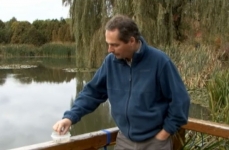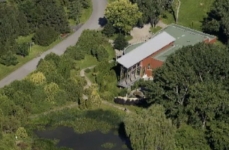Transcription of video clip Around the pond
(Claude Roy, activity leader, presents the pond of the Tree House)

© Jardin botanique de Montréal
Claude Roy, activity leader, Tree House
Well hello, welcome to the Tree House pond.
Tree House pond is home to collections of trees that are adapted to wetlands.

© Jardin botanique de Montréal
The Tree House
So what we find, of course we find northern white cedar and a group of cedars, which are trees well-adapted to aquatic environments.
We also have riparian shrubs like dogwoods as well as a well-known tall tree of Chinese origin, the weeping willow, which towers above this pond.
The Tree House pond is a splendid environment, it teems with life, there is a diversity of fauna and flora.
These living beings have developed all sorts of strategies for adapting to an aquatic environment.
We only have to consider plants, for example.
There are emergent plants that grow with their feet in the water.
There are floating-leaf plants that have a rhizome buried in the pond sediment and spread their leaves and flowers on the surface of the water.
Also, many animals inhabit this pond in the summertime, including mallards. And we can also see mallard ducklings.
And we can also see, for example on a tree trunk, painted turtles and even green frogs warming themselves in the sun.
Imagine, in the heart of Montreal, we can hear concerts by green frogs, right here at the Tree House pond.
We can also see many invertebrates in the heart of this pond just behind me.
And here, we have two insects that are perfectly adapted to an aquatic environment.
Think of the water stick insect, which resembles a branch.
Well, the water stick insect is a voracious predator that clings to foliage and
camouflages itself, hoping to find prey.
Well, here we have an insect, we can see its six legs.
We can clearly see, here, at the tip of its abdomen, a tube that allows it to breathe ambient air, which is very unusual.
So it has really developed a form of respiration, a little like the tuba invented by humans.
So here, we have a backswimmer, an unusual insect because it swims backwards.
So it has big oars, long legs that it has developed to use as oars, that have hairs on the ends.
So, the backswimmer swims backwards, and it is also a predator that has developed quite a strategy for breathing in the water.
In fact, it can attach water bubbles to its hairy abdomen and then explore the bottom of the pond.
When that air supply is gone, it returns to the surface in hope of replenishing its air supply.
So these are very unusual bugs, the backswimmer and the water stick insect.
Back to video clip




